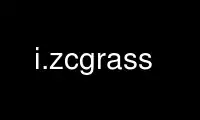
This is the command i.zcgrass that can be run in the OnWorks free hosting provider using one of our multiple free online workstations such as Ubuntu Online, Fedora Online, Windows online emulator or MAC OS online emulator
PROGRAM:
NAME
i.zc - Zero-crossing "edge detection" raster function for image processing.
KEYWORDS
imagery, edges
SYNOPSIS
i.zc
i.zc --help
i.zc input=string output=string [width=integer] [threshold=float]
[orientations=integer] [--overwrite] [--help] [--verbose] [--quiet] [--ui]
Flags:
--overwrite
Allow output files to overwrite existing files
--help
Print usage summary
--verbose
Verbose module output
--quiet
Quiet module output
--ui
Force launching GUI dialog
Parameters:
input=string [required]
Name of input raster map
output=string [required]
Zero crossing raster map
width=integer
x-y extent of the Gaussian filter
Default: 9
threshold=float
Sensitivity of Gaussian filter
Default: 10
orientations=integer
Number of azimuth directions categorized
Default: 1
DESCRIPTION
i.zc is an image processing program used for edge detection. The raster map produced
shows the location of "boundaries" on the input map. Boundaries tend to be found in
regions of changing cell values and tend to run perpendicular to the direction of the
slope. The algorithm used for edge detection is one of the "zero-crossing" algorithms and
is discussed briefly below.
OPTIONS
Parameters:
input_map=name
Name of input raster map layer.
zc_map=name
Name of raster map layer to be used for zero-crossing values.
width=value
This parameter determines the x-y extent of the Gaussian filter. The default value is
9; higher and lower values can be tested by the user. Increasing the width will
result in finding "edges" representing more gradual changes in cell values.
Default: 9
threshold=value
This parameter determines the "sensitivity" of the Gaussian filter. The default value
is 10; higher and lower values can be tested by the user. Increasing the threshold
value will result in fewer edges being found.
Default: 10
orientations=value
This value is the number of azimuth directions the cells on the output raster map
layer are categorized into (similar to the aspect raster map layer produced by the
r.slope.aspect program). For example, a value of 16 would result in detected edges
being categorized into one of 16 bins depending on the direction of the edge at that
point.
Default: 1 The current region definition and mask settings are respected when reading
the input map.
NOTES
The procedure to find the "edges" in the image is as follows:
1 The Fourier transform of the image is taken,
2 The Fourier transform of the Laplacian of a two-dimensional Gaussian function is
used to filter the transformed image,
3 The result is run through an inverse Fourier transform,
4 The resulting image is traversed in search of places where the image changes from
positive to negative or from negative to positive,
5 Each cell in the map where the value crosses zero (with a change in value greater
than the threshold value) is marked as an edge and an orientation is assigned to
it. The resulting raster map layer is output.
Use i.zcgrass online using onworks.net services
